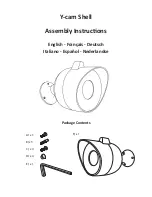
1
CAUTION
Do not back up the motorhome with the towed ve-
hicle attached.
Backing up with the towed vehicle attached will
cause the towed vehicle to “jackknife,” which will dam-
age the tow bar, the baseplate, the receiver hitch, the
towed vehicle’s front end and/or the rear of the mo-
torhome. Backing up with the towed vehicle attached
is the primary cause of tow bar damage and will void
the warranty.
• Be sure the vehicle can be towed
before taking it on
the road. Some vehicles must be equipped with a transmis-
sion lube pump, an axle disconnect, driveline disconnect
or free-wheeling hubs before they can be towed. Failure
to properly equip the vehicle will cause severe damage
to the transmission.
Check the vehicle manufacturer’s instructions for the
proper procedure(s) to prepare the vehicle for towing.
• The tow bar must be within the ‘Safe Zone’
— no
more than three inches above or below level. Towing with
an out-of-level tow bar will cause significant wear and tear
and may result in non-warranty failure and damages. (See
the section titled “Stay within the ‘Safe Zone’” for further
information.)
• The steering wheel must be unlocked and free to
turn when towing.
Failure to do so can cause severe
tire and equipment damage. Check the manufacturer’s
instructions for the proper towing procedure(s).
• The towed vehicle and all its contents cannot exceed
8,000 pounds.
The Sterling tow bar is rated at a maximum
of 8,000 pounds carrying capacity; therefore the towed
vehicle and all its contents cannot exceed 8,000 pounds.
In addition, the receiver hitch, the safety cables and all
supplementary towing equipmentmust be rated at no less
than the weight of the towed vehicle and all its contents.
SAFE TOWING PRACTICES
• Show the owner how to properly operate the tow
bar.
Familiarize yourself with the features of the tow bar.
Demonstrate them to the owner and ask the owner to con-
nect and disconnect the tow bar and other components
of the towing system, until the owner is comfortable with
its operation.
• Advise the owner to always use safety cables when
towing
. The safety cables must connect the towed vehicle
to the towing vehicle, frame to frame.
The capacity of the safety cables must meet or
exceed the towed weight, or the safety cables will fail.
• The tow bar must be attached to a baseplate which
is bolted to the towed vehicle’s frame or unibody.
• Read the instructions thoroughly before installing
the tow bar and its components.
If the tow bar is not
properly aligned, centered and positioned on the towed
vehicle, then excessive tire wear and other consequential,
non-warranty damage may result.
INSTALLER'S SAFETY CHECKLIST
• The installer must NOT use the tow bar as a ground
for welding.
Connecting a ground to the tow bar will cause
current to flow through the locking spring, which will de-
temper the spring and destroy the locking mechanism.
• Under no circumstances should the tow bar be
welded to the vehicle
, nor should any of the pre-punched
mounting holes be altered. Any welding or altering of the
tow bar will void the owner’s warranty.
Failure to follow these instructions may cause prop-
erty damage, personal injury or even death.
• The tow bar must be secured with linch pins (or
optional padlocks) before towing.
Unless the tow bar
is secured to both vehicles with all appropriate pins (or
padlocks), the towed vehicle will detach.
• Inspect the system before towing
— check the mounts,
brackets, fasteners, bolts, wiring, the safety cables and all
other components each time before towing. Additionally,
check the baseplate every 3,000 miles — inspect for any
fractures or cracks in the steel or any visible damage. Do
not tow if the baseplate is damaged.
Additionally, check the torque on all bolts. (To find
the torque ratings, refer to the installation instructions for
the baseplate and the tow bar.)
• This tow bar is designed for use on paved roads
only.
ROADMASTER does not recommend off-road tow-
ing, nor does ROADMASTER warrant the tow bar for off-
road use.
• Never tow a vehicle with one of a comparable
weight.
The towed vehicle’s weight should never exceed
40 percent of the towing vehicle’s weight.
Towing a vehicle with one of similar weight will cause
the towed vehicle to override the towing vehicle, result-
ing in “jackknifing,” “leapfrogging” or “fishtailing.” Serious
damage to both vehicles, as well as the towing system,
could result.
• Always stand to one side and as close to the mo-
torhome as possible when releasing the tow bar lock-
ing mechanisms.
Never stand between the adjustable
arms, or put any part of your body between the adjustable
arms when releasing the tow bar — always stand to one
side.
Because the towed vehicle may jerk forward when the
locking mechanisms are released, face the towed vehicle
and stand as close to the back of the motorhome as pos-
sible before releasing the locking mechanisms, to keep
from being hit by the towed vehicle.
continued on next page






























